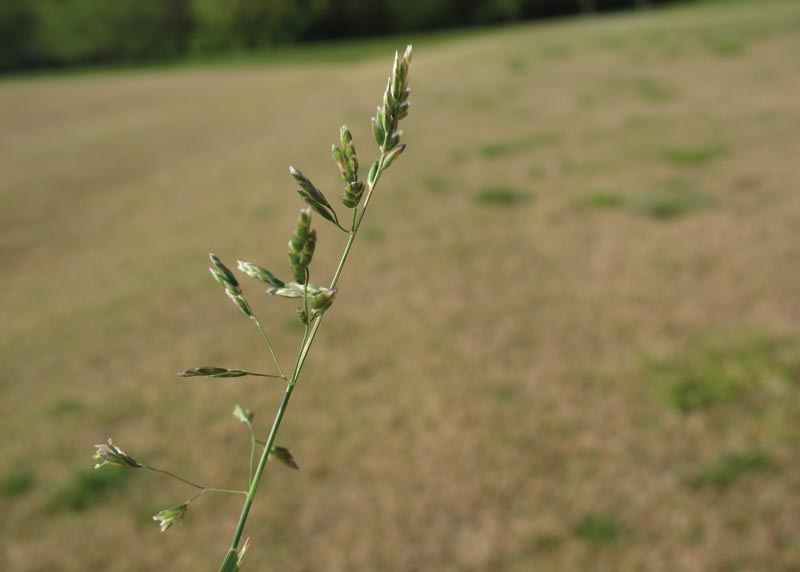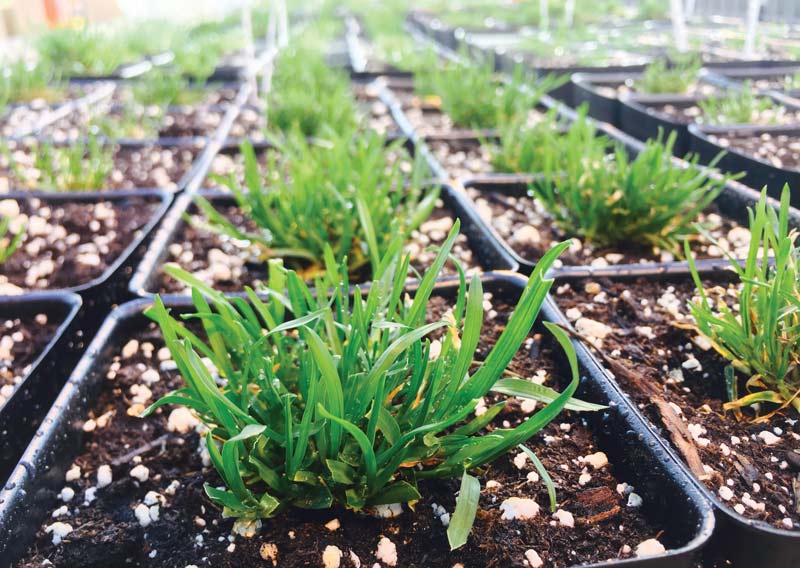
Where Poa annua is not a golf course’s grass of choice, it is considered a pest, as its color and growth habit differ from those of the desired grasses, making it a visual blight as well as a possible impediment to play. Photo by Greg Breeden
Recently, our team began a two-year project surveying annual bluegrass (Poa annua) populations of golf course turf throughout Tennessee and screening plant material collected for resistance to pre- and post-emergence herbicides. Better understanding the scope of herbicide resistance in annual bluegrass populations of Tennessee golf courses will have many benefits for golf course superintendents, including:
- Identification of herbicides that are no longer effective for annual bluegrass control, thereby eliminating wasteful pesticide applications from entering the environment.
- Identification of herbicides that still work on annual bluegrass to ensure superintendents are making only effective applications.
- Baseline data for understanding the full extent of the resistance problem on a large scale rather than relying on case-by-case experiences of resistance at a single location.
What has been done
Plant collection
In East, Middle and West Tennessee, 90 public, private and semiprivate golf courses with a range of maintenance budgets were surveyed from Jan. 3 to Feb. 14, 2018. Surveyors randomly selected one hole at each course and walked the length of that hole, sampling annual bluegrass present above a benchmark density threshold (~11 plants/square yard). Collected plants were transplanted into glasshouse culture at the University of Tennessee, Knoxville, Tenn. Seed was collected from all harvested plants and bulked by location.

Poa annua plants collected in the field were transferred to the greenhouse and grown for seed that would, in turn, be used to grow larger populations to be used for research. Photo by José Javier Vargas
Emergence and seedling vigor experiment
Harvested seed was planted and maintained in a glasshouse under environmental conditions designed for annual bluegrass growth. Plants were allowed to grow until Sept. 7, 2018, when seedling height was recorded to determine seedling vigor.
Resistance to nonselective herbicides
After height data were collected, all trays were trimmed to a uniform height of 2 inches (5 centimeters) and supplied nutrients with a complete fertilizer. After a minimum of 17 days, plants were exposed to glyphosate (Roundup Pro, Monsanto) at 32 fluid ounces/acre (1,120 grams/hectare), glufosinate (Finale, Bayer Environmental Sciences) at 6 quarts/acre (1,680 grams/hectare) or diquat (Reward, Syngenta Professional Products) at 2 quarts/acre (560 grams/hectare). These herbicides represented three distinct modes of action used for post-emergence annual bluegrass control in dormant warm-season turf: WSSA groups 9 (glyphosate), 10 (glufosinate) and 22 (diquat).
Annual bluegrass biotypes were grouped into three categories based on percent survival data: suspected resistant (>30% survival), segregating for resistance (5% to 30% survival) and susceptible (<5% survival). These groupings are similar to those used in a benchmark survey of herbicide resistance in annual ryegrass (Lolium rigidum) populations (1).
What has been learned
Plant collection
Annual bluegrass was present above our benchmark sampling density at 87% of the golf courses surveyed. Of the 12 courses below our threshold, 10 were located in East Tennessee. A low percentage of superintendents indicated they had changed their annual bluegrass management program on fairways and roughs from the previous year — 30% in East Tennessee, 29% in Middle Tennessee and 21% in West Tennessee. The large number of golf courses with annual bluegrass above the benchmark sampling density and the lack of diversity in control programs from year to year validated the rationale of our herbicide-resistant screening.
Emergence and seedling vigor
Annual bluegrass emergence varied according to golf course type, with biotypes from public golf courses emerging in an average of 6.3 days, compared with 8.1 days for biotypes collected from private golf courses. Annual bluegrass seedling vigor varied by region, with biotypes from East and Middle Tennessee growing at a rate of 0.08 to 0.09 inch (0.20 to 0.22 centimeter) per day, compared with only 0.06 inch (0.15 centimeter) per day for those collected from golf courses in West Tennessee.

Researchers sampled Poa annua plants from a randomly selected golf hole at each golf course in the survey. Only 12 golf courses (13%) were eliminated from the study because their Poa annua populations were below the benchmark sampling density. Photo by James Brosnan
Nonselective herbicide response
Neither region, golf course type nor turf species affected survival after glyphosate application. However, 20% of the biotypes tested screened positive for resistance (>30% survival), while only 36% fell into the susceptible grouping (<5% survival). The remainder were intermediate, indicating some level of glyphosate resistance was present within the population. In total, these data indicate that 64% of the annual bluegrass on Tennessee golf courses included in this survey is (or is becoming) resistant to glyphosate.
Biotypes also differed in response to glufosinate and diquat. It should be noted that annual bluegrass treated with these herbicides often exhibits rapid necrosis and recovery after treatment. This effect was observed in our study and could explain the variability in survival observed among biotypes.
This survey of annual bluegrass from Tennessee golf courses is ongoing, with populations being screened against other pre- and post-emergence herbicides during 2019. Recent work includes screening these populations for resistance to prodiamine and foramsulfuron, as well as other modes of action.
Literature cited
- Owen, M.J., M.J. Walsh, R.S. Llewellyn and S.B. Powles. 2007. Widespread occurrence of multiple herbicide resistance in Western Australian annual ryegrass (Lolium rigidum) populations. Australian Journal of Agricultural Research 58:711-718.
James T. Brosnan is an associate professor in the Plant Sciences Department at the University of Tennessee-Knoxville and heads the university’s Weed Diagnostics Center and the turfgrass weed science research and Extension program. José Javier Vargas is a research associate with the Turf and Ornamental Weed Science program at the university and the head diagnostician at the Weed Diagnostics Center. Greg K. Breeden is a weed science Extension assistant at the university and manages the university’s turfgrass weed science field research.